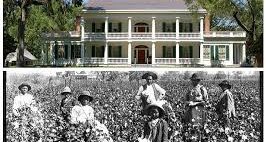A couple of years ago, we were on the last leg of our trip to USA. We were staying in Baton Rouge with my ex teacher and guide. New Orleans and Baton Rouge in deep south are two of my favorite cities in USA. One still senses an old world charm that is missing in many other parts of USA.
It was during our last week that we decided to visit a plantation home. I had read several novels that were written around the civil war and the theme was life around the southern plantation homes. I wanted to have an experience of what a plantation home felt like. My friend had rented a car and we had all driven on the highway to the plantation home, apparently the biggest and the most frequently visited by tourists.
We bought the ten dollar ticket per person. A young white woman led us to the waiting area on the front verandah where the guide, another white woman with a radiant smile waited for the people to assemble. “I am your tour guide. The next tour would begin in fifteen minutes,” she announced. “Make yourself comfortable.” Pointing to the lawn in front she said, “This is the area where the owner and his wife sat and had their evening tea and watched the gate in the distance as to who came and went.”
As far as one could see, the path was covered by golden leaves strewn all over with huge oak trees lining the path on both sides. In the distance the iron gate looked majestic, a remnant of an era gone by.
“I can imagine a horse drawn carriage coming through that gate straight out of Gone with the wind,” an old lady standing next to me amongst the audience remarked. “With Clark Gable at the reins and Scarlett o Hara in the carriage of course. There is something about these homes that takes me straight in the very midst of another era, which is why I come here often,” her friend remarked. A couple of tourists smiled in appreciation.
Our tour guide asked us to follow her. There were now nearly fifty of us, all white families except us, we being the only colored people in the group.
We were shown the large living room and explained the beautiful rugged furniture and then taken to different rooms that catered to different tasks. “The man was a sugar baron and he wanted this plantation to be known as the most exclusive property in the whole of south. There were three hundred slaves who worked here under him on the estate at one point of time,” she explained to us, “and he treated them very humanely,” she said looking at us, conscious now that there were colored people and we didn’t show the same enthusiasm like others.
She showed us a long cloth displayed in a corner. This was apparently woven and gifted by Martha Washington and given to the lady of the home. She rattled of a distant connection that the owners had with George Washington to show the status and importance of the owners.
It was going to be the last leg of the tour. I looked around the group. Most of the tourists by now seemed to be soaking in the whole experience. The tour guide had explained the different activities of the family in a highly romantic way. It seemed they imagined the people who lived there, the tea room where the ladies sat and gossiped, the living room where men smoked cigars and drank till early hours of the morning discussing their business. As they did it following her description, they envisioned the life of the people who lived there around their weddings, the grand ballroom dances where women danced vying for attention from suitors and where they carefully hid their ankles.
Our guide looked satisfied with the expression on the faces of the tourists as the tour was coming to an end. Magnificent, beautiful, no words to describe it, were the various expressions that I heard around me as people assembled to write on the visitors’ book before leaving.
“Excuse me, I have one question for you,” I asked the woman. “You said there were three hundred slaves who lived here. You didn’t show us where they lived. You even showed us the stable for the horses. Why don’t you show us where the slaves lived?”
A sudden silence fell in the room. I sensed a plain disgust in the looks of some of the others. Their experience, their money that they had paid seemed had got wasted with my question.
“I don’t know,” the startled guide replied. “I will ask and come back. You wait,” saying this she left the room. As the guests left, we were the only ones left behind. The woman came back after sometime and said, “I am sorry. The place for slaves fell down sometime ago. We don’t know where it existed and when.”
“You mean the owner, his wife and their eleven children lived in this mansion and three hundred slaves lived nearby on the premises which does not exist anymore?” I said, surprised. “I walked around the ground. There is no sign of any building for three hundred people. Are you sure of the number? Where was the place they lived in? Was their place of residence so small and congested for them?”
“I wish I knew the answers to all these,” she replied.
The story didn’t end here. I was feeling quite heavy inside my heart and decided to take a walk. It wasn’t the romantic place for me that she had painted for all of us but a place where people were perhaps treated as less than human and punished brutally if they disobeyed and ran away. After strolling for some more time on the premises we walked back to the car park. I saw the guide woman once again. She said she was waiting for us.
“You must be thinking what a hypocrite we are. We showed you only a small part of our history and hid the other part. In all these years I have worked here, you are the first person to ask me about slaves and where they lived on the plantation. It completely took me by surprise because that was not what I was taught how to conduct the tour and never expected such a question. I realized that I was to weave a dream for the tourists so that they revel in the memories of that era thinking it to be some kind of a magical period for American history.
“The irony is that,” she continued, “I happen to be a student of American history. Black history or their suffering was never a major part of our course. Perhaps that is why I also never thought of the question how the slaves lived, at least till now.”
Later, coming back from the journey I thought on why I had asked that question. I realized it is so because I, a psychologist, work with survivors and try to understand their history, the narratives about where they come from, what it must have meant for the underdogs who lived as slaves. I am not taken in by the narratives or voices of the rich and the powerful or as presented by guides in historical monuments. I often see that it is those in power who write history by distorting it, sanitize it so that it can be left as a legacy for the future generations and the blood on the hands of the powerful is erased and not noticed.
Today as we see the pictures on television of the statue of the confederate general falling down on the ground in Alabama, it occurs to me that the memory of the trauma after all, is not dead after one hundred and fifty years and the true history of a nation is being raised once again by the survivors of atrocities. A history built around oppression and silence and made to live through its statues and memorials is being brought down by the power of people’s memory.
The recent events in USA also show that memory of a people never dies no matter how much it is suppressed over generations and covered with a sanitized version of the truth that seeks to hide all atrocities. Truth to me can be likened like the stream in mountains that finds its way through rocks resisting it and bursts open through creating cracks. One has to wait for generations but memory never betrays to come out.
The events of Alabama and Charlottesville makes me wonder if memory is always more powerful than history and that history has to bend its knees when forced to do so by the voice of the oppressed one day.
The memory of the Blacks around their slavery, of the Red Indians of their massacre are two realities that shall never meet with the history prepared by earlier white historians. One has to read the novels bury my heart at the wounded knee and twelve years a slave to know to real American history. It may also be said that no nation can exist for long with two different identities built around the events that define its creation, its most important events and its people, one for those in power and another one for oppressed.
This maybe a painful truth that is caught between the narratives of perpetrators and the suppressed in all nations with a violent past.
Closer home in India, there is a struggle between memory and history that is tearing at the identity of our nation and our people. There is many a memory that wants to break loose from the shackles it has been held in by the narratives prepared by the ones in power during the colonial times and after our independence. A new identity may soon find its way that will come out of the womb of memory that pines for freedom from the prison of ignorance and falsehood. The story of our freedom struggle, the sacrifices of our revolutionaries who gave their blood for India’s freedom, the history of those who faced atrocities in the name of religion during the previous centuries are all untold fragments that are yet to find their moment of expression.
In my book ‘The infidel next door’ there is a conflict about memory and history between the characters of Professor Baig and Aditya when the professor tells him, “The struggle between history and memory is eternal for mankind, Aditya. It is our memory that heals us, not history from injustices of the past. History puts a blind on us, making us believe that we are prisoners. History is like an empress, angry with a whip in hand who demands obedience to the written word. Memory is like the mother who holds us in embrace protecting us when our soul needs answers.”
It is such moments that by reckoning the memory of its people, a race keeps alive the conscience of a nation. This moment may deserve and need all the space and courage that the people of a nation can gather. Only then will justice in the life of a nation find its true meaning.

